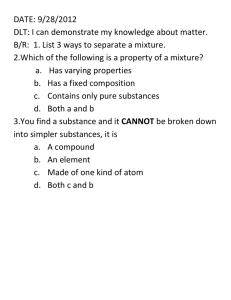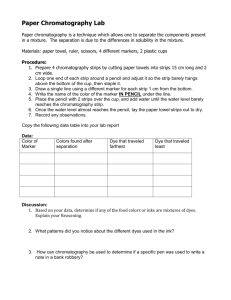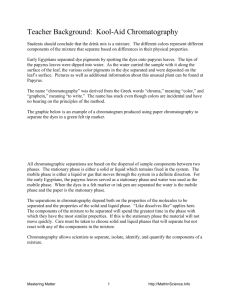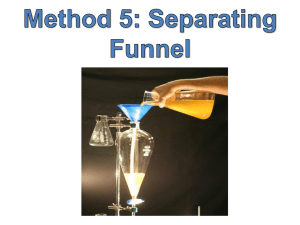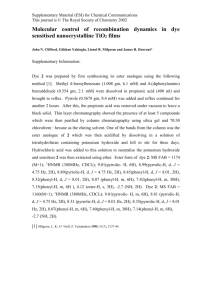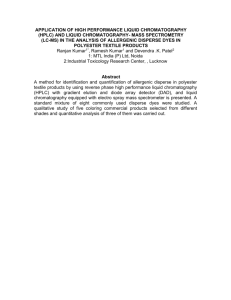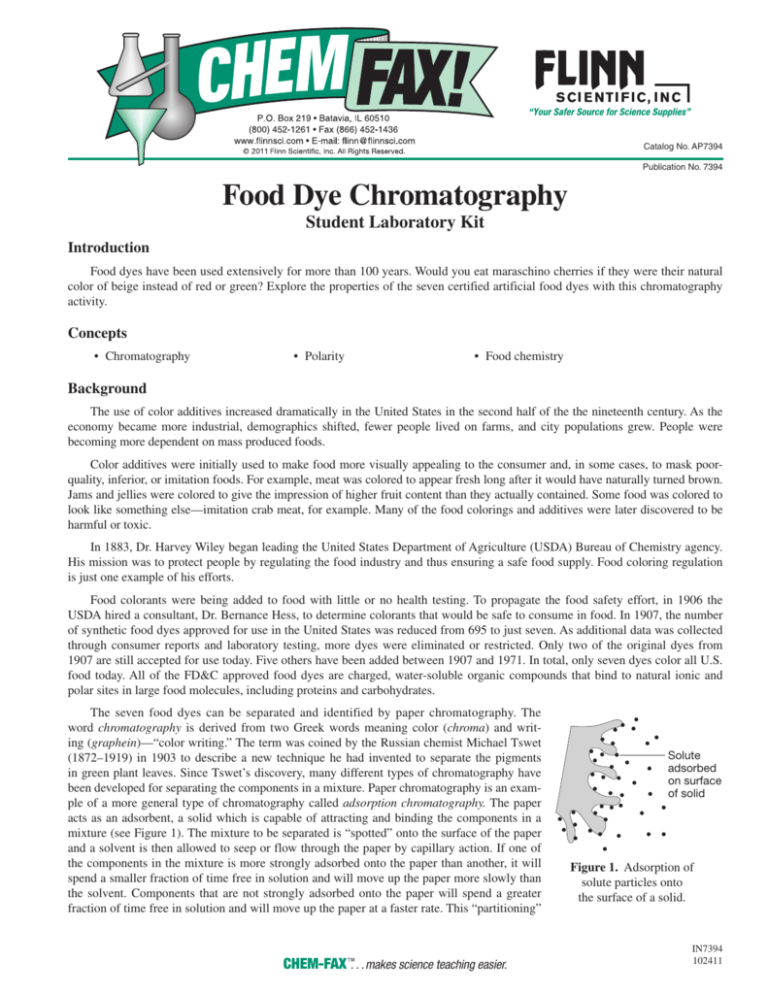
Catalog No. AP7394
Publication No. 7394
Food Dye Chromatography
Student Laboratory Kit
Introduction
Food dyes have been used extensively for more than 100 years. Would you eat maraschino cherries if they were their natural
color of beige instead of red or green? Explore the properties of the seven certified artificial food dyes with this chromatography
activity.
Concepts
• Chromatography
• Polarity
• Food chemistry
Background
The use of color additives increased dramatically in the United States in the second half of the the nineteenth century. As the
economy became more industrial, demographics shifted, fewer people lived on farms, and city populations grew. People were
becoming more dependent on mass produced foods.
Color additives were initially used to make food more visually appealing to the consumer and, in some cases, to mask poorquality, inferior, or imitation foods. For example, meat was colored to appear fresh long after it would have naturally turned brown.
Jams and jellies were colored to give the impression of higher fruit content than they actually contained. Some food was colored to
look like something else—imitation crab meat, for example. Many of the food colorings and additives were later discovered to be
harmful or toxic.
In 1883, Dr. Harvey Wiley began leading the United States Department of Agriculture (USDA) Bureau of Chemistry agency.
His mission was to protect people by regulating the food industry and thus ensuring a safe food supply. Food coloring regulation
is just one example of his efforts.
Food colorants were being added to food with little or no health testing. To propagate the food safety effort, in 1906 the
USDA hired a consultant, Dr. Bernance Hess, to determine colorants that would be safe to consume in food. In 1907, the number
of synthetic food dyes approved for use in the United States was reduced from 695 to just seven. As additional data was collected
through consumer reports and laboratory testing, more dyes were eliminated or restricted. Only two of the original dyes from
1907 are still accepted for use today. Five others have been added between 1907 and 1971. In total, only seven dyes color all U.S.
food today. All of the FD&C approved food dyes are charged, water-soluble organic compounds that bind to natural ionic and
polar sites in large food molecules, including proteins and carbohydrates.
The seven food dyes can be separated and identified by paper chromatography. The
word chromatography is derived from two Greek words meaning color (chroma) and writing (graphein)—“color writing.” The term was coined by the Russian chemist Michael Tswet
(1872–1919) in 1903 to describe a new technique he had invented to separate the pigments
in green plant leaves. Since Tswet’s discovery, many different types of chromatography have
been developed for separating the components in a mixture. Paper chromatography is an example of a more general type of chromatography called adsorption chromatography. The paper
acts as an adsorbent, a solid which is capable of attracting and binding the components in a
mixture (see Figure 1). The mixture to be separated is “spotted” onto the surface of the paper
and a solvent is then allowed to seep or flow through the paper by capillary action. If one of
the components in the mixture is more strongly adsorbed onto the paper than another, it will
spend a smaller fraction of time free in solution and will move up the paper more slowly than
the solvent. Components that are not strongly adsorbed onto the paper will spend a greater
fraction of time free in solution and will move up the paper at a faster rate. This “partitioning”
CHEM-FAX. . .makes science teaching easier.
Solute
adsorbed
on surface
of solid
Figure 1. Adsorption of
solute particles onto
the surface of a solid.
IN7394
102411
of the components of a mixture between the paper and the solvent separates the components and gives rise to different bands or
spots. If the components of the mixture are colored, like the food dyes or pigments in an ink, the bands are easily distinguished.
Different samples will spend varying amounts of time interacting with the paper and the solvent. Through these different
interactions, the samples will move different distances along the chromatography paper. In general, food dye molecules that are
more highly charged, that is, have more ionic binding sites, and are more polar will be attracted to the paper more strongly and
will thus have lower Rf values. The distance a sample moves along the chromatography paper is compared to the overall distance
the solvent travels—this ratio is called the Rf or rate of flow.
Experiment Overview
The purpose of this experiment is to use paper chromatography to separate the components of the seven Food, Drug, and
Cosmetic (FD&C) food dyes. The Rf value of each substance will be calculated and compared to determine the composition of
food dyes in an unknown mixture.
Pre-Lab Questions
1. What is the primary factor influencing the distance a sample will move along the chromatography paper compared to the
solvent?
2. Check for food labels at home or in a grocery store and find items with food dyes in them. List the food(s) and the FD&C
dyes included in the ingredient list.
Materials
Dye mixture solution A, 1 mL
Sodium chloride solution, NaCl, 0.1%, 50 mL
Dye mixture solution B, 1 mL
Beaker, tall-form, 1000-mL
Food Dye FD&C Blue No. 1, 0.5%, 1 mL
Chromatography paper, 20 cm × 20 cm
Food Dye FD&C Blue No. 2, 0.5%, 1 mL
Pencil
Food Dye FD&C Green No. 3, 0.5%, 1 mL
Ruler
Food Dye FD&C Red No. 3, 0.5%, 1 mL
Scissors
Food Dye FD&C Red No. 40, 0.5%, 1 mL
Stapler
Food Dye FD&C Yellow No. 5, 0.5%, 1 mL
Toothpicks, 9
Food Dye FD&C Yellow No. 6, 0.5%, 1 mL
Watch glass that fits on tall-form beaker
Safety Precautions
The FD&C dyes are slightly hazardous by ingestion, inhalation, eye and skin contact. Red No. 40 may be absorbed through
skin and Yellow No. 5 may be a skin contact sensitizer. All are irritating to skin and eyes. Avoid contact with eyes, skin, and clothing. Wear chemical splash goggles, chemical-resistant gloves, and a chemical-resistant apron. Use proper exhaust ventilation to
keep airborne concentrations low. Wash hands thoroughly with soap and water before leaving the laboratory. Please follow all
laboratory safety guidelines.
Procedure
2 cm
1. Cut 2 cm off of one side of the chromatography paper making the new paper dimensions 20 cm × 18 cm (see Figure 2). Note: Handle the paper by the edges so the analysis area is not accidently compacted or contaminated.
18 cm
2. Orientate the chromatography paper so that it is 20 cm wide and 18 cm tall.
3. Using a ruler and a pencil, draw a faint line 1.5 cm from the bottom of the paper across
the entire width of the paper (see Figure 3).
20 cm
Figure 2.
–2–
IN7394
© 2010 Flinn Scientific, Inc. All Rights Reserved. Reproduction permission is granted only to science teachers who have purchased Food Dye Chromatography, Catalog No. AP7394, from Flinn
Scientific, Inc. No part of this material may be reproduced or transmitted in any form or by any means, electronic or mechanical, including, but not limited to photocopy, recording, or any information
storage and retrieval system, without permission in writing from Flinn Scientific, Inc.
4. Using the same ruler and pencil, draw nine small dots. Measure 2 cm from the edge
for the first dot on the line drawn in step 3 and then add a dot every 2 cm across the
line. Label the first dot 1 (see Figure 3).
1
3
5
7
9
18 cm
5. Obtain the seven 0.5% individual dye solutions and two “unknown” dye mixtures.
6. List on the data table the location where each dye will be placed. Note: Dye samples
may be spotted in any order but location must be recorded.
} 1.5 cm
2 cm
8. Using a clean toothpick for each individual dye sample, spot the chromatography
paper by putting the toothpick into the dye sample solution and then touch the tip of
the toothpick gently onto a self-designated pencil dot. Repeat the procedure as necessary to increase the concentration of the sample but do not increase the size of the dot.
}
}
7. Label the top of the chromatography paper in pencil, dot 1 = 1, dot 2 = 2.
2 cm
20 cm
Figure 3.
9. After spotting all nine samples, wait 1–2 minutes for the samples on the chromatography paper to completely dry.
10. While the sample is drying obtain the 1000-mL tall-form beaker and watch glass that is sized to fit the tall-form beaker.
(Note: See teacher list for other options if tall-form beakers are not available.)
11. Pour 50 mL of 0.1% NaCl solution into the tall-form beaker and cover the top of the beaker with a watch glass. This is the
chromatography chamber. The 0.1% NaCl is the developing solvent.
12. Once the sample is dry, wrap the chromatography paper into a cylinder,
and slightly overlap the blank ends. Staple, being careful not to disrupt
the samples (see Figure 4).
13. Remove the watch glass from the tall-form beaker and carefully place
the cylinder-shaped chromatography paper into the prepared chromatography chamber with the sample end down (as shown in Figure 5).
Do not get any solvent on the upper portion of the chromatography
paper. The sample spots must remain above the level of the solvent. If
the solvent level is too high, the samples will dilute into the solvent!
Paper
Developing
solvent
0.1% NaCl
Figure 4.
Figure 5.
14. Place the watch glass back on the tall-form beaker. Allow the chromatography paper to develop. Note: This should take
15–25 minutes.
15. When the developing solvent is within 1–2 cm of the top of the chromatography paper, stop the run by removing the rolled
chromatography paper from the beaker.
16. With a pencil, lightly draw a line to mark the distance the solvent traveled to the top of the chromatography paper. This is
called the solvent front.
17. Gently remove the staples and lay the chromatography paper flat.
18. Measure the distance from the pencil line at the bottom of the chromatography paper to the solvent front. Record this distance in cm on the worksheet.
19. In pencil, trace the shape of each dye band or spot to mark the location of each separated band on the chromatography
paper. This should be done immediately because the color and brightness of some spots may fade over time.
20. Measure the distance traveled in cm by each dye in each pure solution or mixture. Measure from the line at the bottom of
the paper to the center of each band. Record the results in cm on the worksheet.
–3–
IN7394
© 2010 Flinn Scientific, Inc. All Rights Reserved. Reproduction permission is granted only to science teachers who have purchased Food Dye Chromatography, Catalog No. AP7394, from Flinn
Scientific, Inc. No part of this material may be reproduced or transmitted in any form or by any means, electronic or mechanical, including, but not limited to photocopy, recording, or any information
storage and retrieval system, without permission in writing from Flinn Scientific, Inc.
Name:_____________________________________
Food Dye Chromatography Worksheet
Data Table
To compare and identify compounds separated by paper chromatography, you can calculate the Rf (rate of flow) value for
each dye using the formula below.
distance traveled by dye
Rf = ——————————————
distance traveled by solvent front
To maintain consistency, always measure from the pencil line marked at the bottom of the chromatography paper to the center
of each spot. Record Rf values for each of the dyes.
Distance traveled by solvent front _________ cm.
Location
from left
Name of dye
or unknown
Sample color
Distance traveled
by dye (cm)
Rf calculated
1
2
3
4
5
6
7
8
9
Post-Lab Questions (Use a separate sheet of paper to answer the following questions.)
1. Calculate the Rf value for each dye in both the pure solutions and unknown mixtures. Record the results in the data table.
2. Identify the dyes present in the unknown mixtures. Include supporting data and reasoning for your conclusions.
3. Compare the Rf values of the pure dyes. Which pairs of dyes appeared to have very similar properties, based on their Rf
values, despite their different colors?
4. Which food dye(s) had the greatest interaction with or affinity for the paper versus the solvent? Explain.
5. You are asked to mix an additional experimental unknown and want to make sure the mixture is a challenging one. Using
observations and data from the completed experiment, develop a new three-dye component mixture that may be difficult to
analyze. Explain why you chose this mixture.
–4–
IN7394
© 2011 Flinn Scientific, Inc. All Rights Reserved. Reproduction permission is granted only to science teachers who have purchased Food Dye Chromatography, Catalog No. AP7394, from Flinn
Scientific, Inc. No part of this material may be reproduced or transmitted in any form or by any means, electronic or mechanical, including, but not limited to photocopy, recording, or any information
storage and retrieval system, without permission in writing from Flinn Scientific, Inc.
Teacher’s Notes
Food Dye Chromatography
Materials Included in Kit (for 15 groups of students)
Food Dye FD&C Blue No. 1, 2 g
Food Dye FD&C Blue No. 2, 2 g
Food Dye FD&C Green No. 3, 1 g
Food Dye FD&C Red No. 3, 1 g
Food Dye FD&C Red No. 40, 2 g
Food Dye FD&C Yellow No. 5, 2 g
Food Dye FD&C Yellow No. 6, 2 g
Sodium chloride, NaCl, 0.1 g
Chromatography paper 20 cm × 20 cm, 15
Toothpicks, 150
Additional Materials Needed (for each lab group)
Beaker, tall-form, 1000-mL
Pencil
Ruler
Scissors
Stapler
Watch glass, large (to fit beaker)
Additional Materials Needed (for Pre-Lab Preparation)
Water, distilled or deionized
Beakers, 250-mL, 7
Graduated cylinder, 100-mL
Unknown dye mixtures
Pre-Lab Preparation
1. To prepare the individual dye solutions, add each 0.5 g of solid dye to separate beakers with 100 mL of distilled or deionized water each and mix thoroughly.
2. Dissolve 1 g of solid sodium chloride in 1000 mL of distilled or deionized water and mix thoroughly.
3. See the Lab Hints section for suggestions for unknown mixtures of dyes.
Safety Precautions
The FD&C dyes are slightly hazardous by ingestion, inhalation, and eye or skin contact. Red No. 40 may be absorbed
through skin and Yellow No. 5 may be a skin contact sensitizer. All are irritating to skin and eyes. Avoid contact with eyes, skin,
and clothing. Wear chemical splash goggles, chemical-resistant gloves, and a chemical-resistant apron. Remind students to wash
their hands thoroughly with soap and water before leaving the laboratory. Please review current Material Safety Data Sheets for
additional safety, handling, and disposal information.
Disposal
Please consult your current Flinn Scientific Catalog/Reference Manual for general guidelines and specific procedures, and
review all federal, state and local regulations that may apply, before proceeding. Excess dye solutions and sodium chloride solution may be disposed of down the drain with plenty of excess water according to Flinn Suggested Disposal Method #26b.
Connecting to the National Standards
This laboratory activity relates to the following National Science Education Standards (1996):
Unifying Concepts and Processes: Grades K–12
Evidence, models, and explanation
Constancy, change, and measurement
Content Standards: Grades 5–8
Content Standard A: Science as Inquiry
Content Standard B: Physical Science, properties and changes of properties in matter, motions and forces,
Content Standards: Grades 9–12
Content Standard A: Science as Inquiry
Content Standard B: Physical Science, structure and properties of matter, motions and forces
–5–
© 2010 Flinn Scientific, Inc. All Rights Reserved.
IN7394
Teacher’s Notes continued
Lab Hints
• Enough materials are provided in this kit for 30 students working in pairs, or for 15 groups of students. Both parts of this
laboratory activity can reasonably be completed in one 50-minute class period. The Pre-Laboratory assignment may be
completed before coming to lab, and the data analysis and Post-Lab Questions may be completed the day after the lab.
• Suggestions for unknown mixtures: a) Red No. 3, Blue No. 2, and Yellow No. 5, b) Red No. 40, Yellow No. 6, Blue No. 1,
c) Red No. 3, Green No. 3, Blue No. 1, d) Red No. 3, Red No. 40, and Blue No. 2. Mix equal volumes of each dye desired
to create a mixture.
• In this activity, it is extremely important that the initial sample spots are as small as possible. If the spots are too large or if
there is too much material (dye) on the initial spot, the students may only see a streak of color up the entire chromatogram.
• Allowing enough time for the development of the chromatography paper is critical. The chromatography paper must be
left in the chromatography chamber long enough for the solvent to be drawn up near the top of the strip. Do not stop the
development until the solvent front nears the top of the strip. Underdevelopment will lead to incomplete separation. Do not
allow the solvent front to move off the paper, however.
• Solvent used for development can be reused. Leftover chromatography solvent can be saved and used by another class.
• Other size beakers or mason jars will also work for chromatography chambers—however, the taller the better. Covering
alternatives for the chromatography chambers include plastic wrap, Petri dishes, and other suitable inert coverings such as
Parafilm “M”.® If changing chromatography chamber components, reconfigure the chromatography paper to fit the alternative chromatography chamber. If needed, other filter paper sizes and shapes can be used such as radial circular paper.
Confirm all modified materials are acceptable by conducting a lab trial before introducing the procedure to students.
• Extra dyes are provided for chromatography and spectroscopy lab activities. Other FD&C food dye kits available
from Flinn Scientific include Exploring Chemical Reactions with Food Dyes, Catalog No. AP7418, and Quantitative
Determination of Food Dyes, Catalog No. AP7428.
Teaching Tips
• The structures of the food dyes are shown in the Supplementary section at the end of these kit instructions.
• Connect with the history of food dyes and have students find a substance now considered toxic that was once purposely added to food.
Blue No. 1
• Encourage students to try other solvent mixtures to achieve different
or better separations.
• Students can construct a design of experiment (DOE) to identify the
dyes in for colored food products such as M&Ms or Skittles. Candy
may be placed in 5–6 drops of water. Stir the candy until the color dissolves. Repeat with two more candies. This is the color extract sample.
• Expand the students chromatographic repertoire by using Sep–Pak
C18 Cartridges such as Flinn Scientific Kit AP9093.
Answers to Pre-Lab Questions (Student answers will vary.)
1. What is the primary factor determining the distance a sample will
move along the chromatography paper?
Green No. 3
Yellow No. 6
Blue No. 2
Red No. 40
The attraction between the sample and the chromatography paper
determines how much time the sample spends bonded to the paper
and how much time it remains in solution. These factors determine the
distance/time a sample will move.
2. Check for food labels at home or in a grocery store and find items
with food dyes in them. List the food(s) and the FD&C dyes included
in the ingredient list.
Yellow No. 5
Student answers will vary. Much of the processed food today has dyes
in it.
Red No. 3
Sample Unknown Mixtures Results
–6–
© 2011 Flinn Scientific, Inc. All Rights Reserved.
IN7394
Teacher’s Notes continued
Sample Data Table (Student data will vary.)
Location
from left
Name of dye
or unknown
Distance traveled
by dye (cm)
Rf calculated
1
Yellow No. 5
Yellow
10.2
0.71
2
Blue No.2
Dark navy blue
5.0
0.35
3
Green No.3
Dark blue-green
12.0
0.90
4
Red No.3
Red
1.5
0.10
5
Blue No.1
Dark turquoise blue
12.6
0.88
6
Red No.40
Dark red
4.5
0.31
7
Yellow No.6
Dark orange
7.5
0.52
8
Mixture 1
Dark reddish brown
0.96/4.80/9.18/11.2
0.067/0.34/0.64/0.78
9
Mixture 2
Dark reddish brown
3.09/6.30/8.64/11.3
0.22/0.44/0.60/0.79
Sample color
Answers to Post-Lab Questions (Student answers will vary.)
1. Calculate the Rf value for each dye in both the pure solutions and unknown mixtures. Record the results in the data table.
See data table for sample data.
2. Identify the dyes present in the unknown mixtures. Include supporting data and reasoning for your conclusions.
Answers will vary depending on the unknown mixtures. Students should cite references to visual color and rate of flow—Rf..
3. Compare the Rf values of the pure dyes. Which pairs of dyes appeared to have very similar properties, based on their Rf
values, despite their different colors?
Red No. 40 and Blue No. 2 had similar Rf values as did Blue No. 1 and Green No. 3.
4. Which food dye(s) had the greatest interaction with or affinity for the paper versus the solvent? Explain.
A high interaction or affinity for the paper would take quite a bit of time and the sample would not move very much resulting in a low distance traveled. Red No. 3 has a very low distance traveled, showing it has more affinity for the paper than
the solvent.
5. You are asked to mix an additional experimental unknown and want to make sure the mixture is a challenging one. Using
observations and data from the completed experiment, develop a new three-dye component mixture that may be difficult to
analyze. Explain why you chose this mixture.
Several student answers may be correct. Examples may include: A mixture containing Blue No. 1 and Green No. 3 might be
hard to separate due to rate-of-flow values. A mixture containing Yellow No. 5 and Yellow No. 6 is visually hard to separate.
Reference
Markow, P. G. The Ideal Solvent for Paper Chromatography of Food Dyes. J. Chem. Ed. 1988, 65, 10, pp 899–900.
The Food Dye Chromatography—Student Laboratory Kit is available from Flinn Scientific, Inc.
Catalog No.
AP7394
AP7375
AP4299
AP7418
AP7428
Description
Food Dye Chromatography—Student Laboratory Kit
FD&C Food Dyes, Set of 7
Chromatography Paper
Exploring Chemical Reactions with Food Dyes
Quantitative Determination of Food Dyes
Consult your Flinn Scientific Catalog/Reference Manual for current prices.
–7–
© 2011 Flinn Scientific, Inc. All Rights Reserved.
IN7394
Teacher’s Notes continued
Supplementary Information
SO 3 Na
SO3 Na
NH(C 2 H5 )CH 2
C
O
NaO3S
SO3 Na
N
N
N(C2 H5 )CH2
Figure 1. FD&C Blue No. 1
HO
SO3Na
O
Figure 2. FD&C Blue No. 2
SO3 Na
SO3 Na
NH(C2 H 5 )CH 2
I
C
I
NaO
O
O
I
SO 3 Na
I
CO2Na
N(C 2 H5 )CH2
Figure 4. FD&C Red No. 3
Figure 3. FD&C Green No. 3
OCH3
N
NaO3S
HO
SO3Na
HO
N
N
NaSO3
CH3
N
N
NaO2C
SO3Na
Figure 5. FD&C Red No. 40
NaO3S
N
Figure 6. FD&C Yellow No. 5
N
N
SO3Na
Figure 7. FD&C Yellow No. 6
–8–
© 2011 Flinn Scientific, Inc. All Rights Reserved.
IN7394

